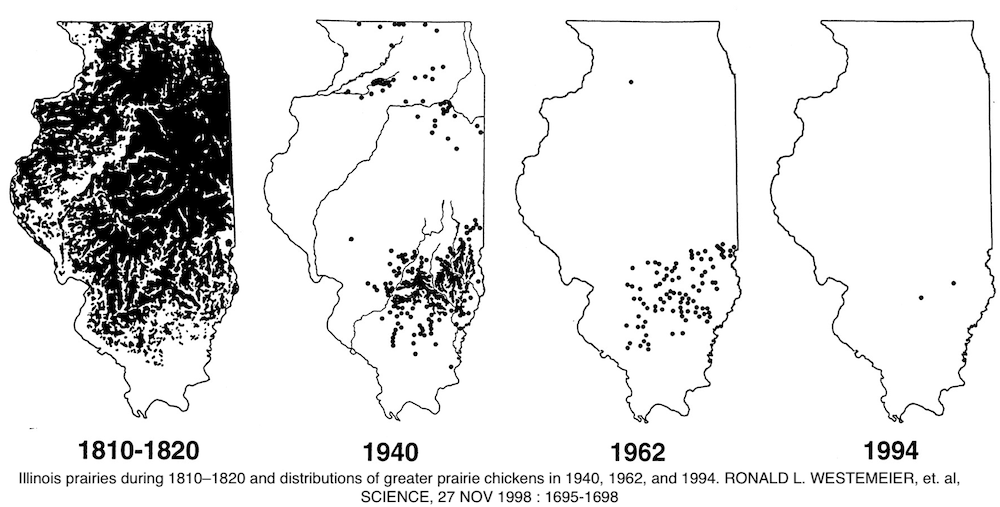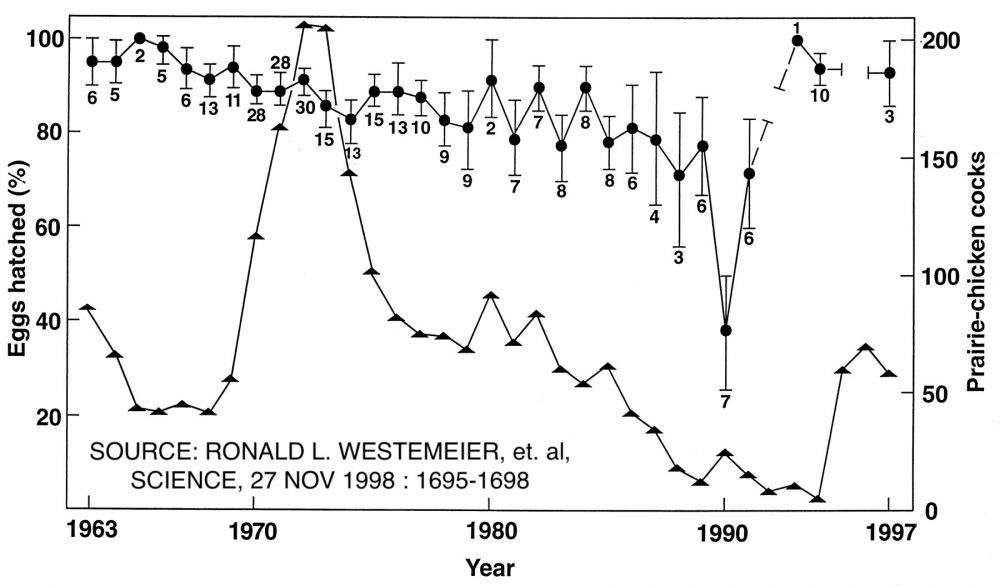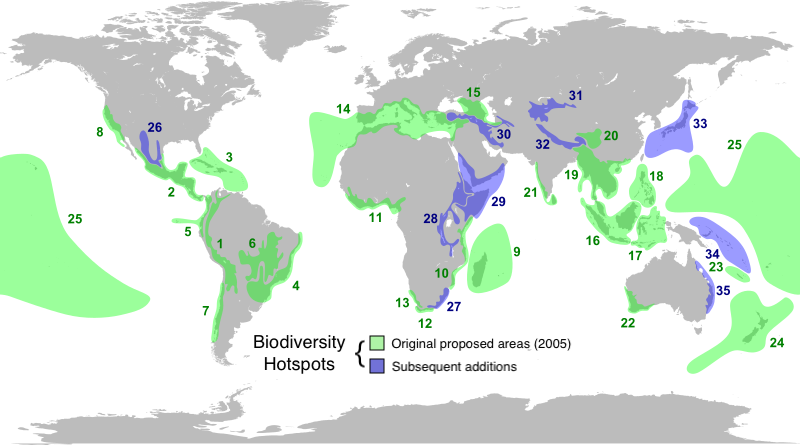1. What can be done?
Stemming the tide of the Sixth Extinction will require changes in the way we humans interact with one another and with the natural world. Some of these changes include
- Controlling human population growth. The Earth is finite. To a large degree, more people on the planet means more resources (especially land) that get allocated to meet human needs. The more land that gets devoted to human needs, the less undeveloped habitat there is for wildlife.
A hopeful trend already underway is that the growth rate for the human population is dropping. This process is called the demographic transition. Elevating the economic and educational status of women —a good thing in and of itself— is the most effective way to limit human population growth. Why? Because women with more economic and educational opportunities tend to have smaller families, simply because they have their first child later in life. So promoting women’s equality worldwide helps humanity, promotes biodiversity, and enhances equality and social justice. - Shifting from fossil fuels to renewable energy to reduce climate change. Anthropocentric climate change is creating habitat disturbances at a rate that wildlife can’t adapt to. If we want to maintain habitat, especially in tropical areas that are the highest in biodiversity, we need to slow the rate of human-caused climate change (or stop it altogether). To do that, we need to stop releasing carbon dioxide and other greenhouse gases into the atmosphere. And to do that, we need to shift from fossil fuel combustion in cars, factories, and power plants to non-carbon-based energy sources like wind and solar.
On a smaller scale, we can take some actions to rescue and preserve species that are in (or on the verge of entering) the extinction vortex. So to start, let’s review how the extinction vortex works.
[qwiz qrecord_id=”sciencemusicvideosMeister1961-Extinction Vortex Diagram (v2.0)”]
[h]Reviewing the Extinction Vortex
[q labels = “top”]
[l]smaller population
[fx] No. Please try again.
[f*] Great!
[l]less fertility, more mortality
[fx] No, that’s not correct. Please try again.
[f*] Good!
[l]genetic drift
[fx] No, that’s not correct. Please try again.
[f*] Correct!
[l]loss of genetic diversity
[fx] No. Please try again.
[f*] Excellent!
[/qwiz]
2. Protecting endangered species
Species are disappearing at such a high rate that many are being lost before we can take any action. However, legislation like the US’s Endangered Species act, passed in 1973, has made it a legal obligation to “protect and recover imperiled species and the ecosystems upon which they depend” (US Fish and Wildlife Service). Because of laws like the Endangered Species Act, many species are recovering from direct or indirect threats. This includes the California condor, the Black Footed Ferret, the Florida Manatee, the American Alligator, and many others (see this article in the Washington Post).
3. Renewing Genetic Variation in Declining Populations
In some cases, it’s possible to introduce genetic diversity into a declining population. This was what was done to prevent the Illinois population of the Greater Prairie Chicken from becoming extinct.
Greater Prairie Chickens are known for their incredible mating displays. Here’s how this is described in All About Birds from Cornell University.
Few performances in the bird world are more memorable than the dawn display of Greater Prairie-Chickens at their booming ground, or lek—the traditional spot where males dance, call, and try to impress females with their vigor. When displaying, the males erect ear-like plumes on the head and blow up bright orange air sacs on the neck, transforming themselves from brownish chicken-like birds into brightly colored performers, all the while drumming with their feet and producing whooping and cackling calls.
Here’s a short video of these birds in action.
Based on historical records, Greater Prairie chickens in Illinois had experienced a steep decline in numbers and distribution, as shown below.

Based on everything you’ve learned above, you could expect that by 1994, the two isolated Illinois populations were experiencing genetic drift and reduced fertility.
You can see this in the graph below. The triangles show the number of males observed in the breeding areas. The circles represent the percentage of eggs hatched, and the numbers below the error bars represent the number of nests.
By the late 1980s, the number of males on the breeding grounds had declined to perilously low levels. The total number of birds in Illinois was less than 50. Following the prediction that a low population leads to lowered fertility, the percentage of eggs hatching was also dropping. During several years during the 1980s, success rates fell below 80%, and there was a steep decline in successful egg hatching in 1990.
To reverse the slide toward extinction, researchers brought in 271 Greater Prairie chickens from large populations in Minnesota, Kansas, and Nebraska. While some transplanted birds didn’t survive beyond their first year, others did and integrated into the breeding population.
The results can be seen in the years following 1992, with the percentage of eggs hatching rising to 94%. This was accompanied by an increase in the number of males displaying on breeding grounds.
This kind of intervention only worked because there were other populations whose genetic variability could be used to replenish the gene pool of the Illinois population. For isolated populations in steep decline, that might not be possible.
4. Proper nature reserve design is key
A nature reserve is an area that’s managed to preserve its plants, animals, and physical features. Let’s start by applying some of the principles we’ve covered in this tutorial to the design of nature reserves.
[qwiz qrecord_id=”sciencemusicvideosMeister1961-Nature reserve design (v2.0)”]
[h]Nature reserve design
[i]
[q labels = “top”]The images below show different reserve designs. Label them as “better” or “worse.”
[l]better
[fx] No, that’s not correct. Please try again.
[f*] Good!
[l]worse
[fx] No. Please try again.
[f*] Correct!
[q labels = “top”]Now repeat the process with these three reserve designs
[l]better
[fx] No, that’s not correct. Please try again.
[f*] Correct!
[l]worse
[fx] No, that’s not correct. Please try again.
[f*] Correct!
[q]Let’s analyze these reserves in a bit more detail. All the reserves in column B are better at preserving biodiversity because they allow for a [hangman] population size (begins with “l”). This reduces genetic [hangman]. Clustering several reserves near one another allows for [hangman] flow between adjacent populations.
[c]bGFyZ2Vy[Qq]
[c]ZHJpZnQ=[Qq]
[c]Z2VuZQ==[Qq]
[q]The corridor in the top left of the diagram below is an even more direct method of allowing for gene [hangman] between adjacent populations. Having diverse ecosystems allows for more complex animal habitat needs. For example, amphibians need both freshwater and terrestrial habitats. The advantage of the round reserve over the thin reserve is that the round reserve has less [hangman]. In other words, the thin habitat might have no viable interior [hangman].
[c]Zmxvdw==[Qq]
[c]ZWRnZQ==[Qq]
[c]aGFiaXRhdA==[Qq]
[/qwiz]
5. Protecting Biodiversity Hotspots
We’ve seen that in some cases, direct interventions can prevent species from becoming extinct. We’ve also looked at how nature reserves can be designed to
- minimize fragmentation,
- minimize the edge effect,
- be large enough to support the wildlife living inside of them
- maximize healthy population size and gene flow between adjacent wildlife populations.
Another move can be to protect biodiversity hotspots.

Biodiversity hotspots are high biodiversity areas that are under threat. They
- Have at least 1500 endemic plant species. Endemic species are those found in one location, and nowhere else. A high diversity of endemic plants is often an indicator of a high diversity of all types of wildlife.
- Have less than 30% of their original vegetation (because of habitat destruction or degradation).
Around our planet, 36 areas have been identified as hotspots. These areas cover only 2.4% of the Earth’s surface, but they support more than half of the world’s plant species. The hottest hot spots — with a total area of only 1.5% of the Earth’s surface — are home to about a third of the Earth’s birds, amphibians, mammals, and plants.
6. Disruptions to Ecosystems, Cumulative Quiz
[qwiz qrecord_id=”sciencemusicvideosMeister1961-Disruptions to Ecosystems, Cumulative Quiz (v2.0)”]
[h] Disruptions to Ecosystems
[i] Biohaiku
The Sixth Extinction.
Anthropocene Legacy
That will long endure
[q] The name of the age in which humans have become the dominant biological force is the [hangman].
[c]IEFudGhyb3BvY2VuZQ==[Qq]
[f]IEdyZWF0IQ==[Qq]
[q] A key process that’s driving the biodiversity losses of the Sixth Extinction is human destruction of wildlife [hangman].
[c]IGhhYml0YXQ=[Qq]
[f]IEV4Y2VsbGVudCE=[Qq]
[q] Sometimes habitat isn’t completely lost. But its quality can be [hangman] (begins with “d”) to the point where wildlife can no longer live in it.
[c]IGRlZ3JhZGVk[Qq]
[f]IEV4Y2VsbGVudCE=[Qq]
[q multiple_choice=”true”] It’s been estimated that humans have modified ______ percent of the Earth’s land surface.
[c]IDEw[Qq]
[f]IE5vLiBNb3JlIHRoYW4gMTAlLg==[Qq]
[c]IDMw[Qq]
[f]IE5vLiBNb3JlIHRoYW4gMjAl[Qq]
[c]ID Uw[Qq]
[f]IEV4YWN0bHkuIEh1bWFucyBoYXZlIG1vZGlmaWVkIGFib3V0IDUwJSBvZiB0aGUgRWFydGgmIzgyMTc7cyBsYW5kIHN1cmZhY2Uu[Qq]
[c]IDkw[Qq]
[f]IE5vLiBJdCYjODIxNztzIGxlc3MgdGhhbiA5MCUu[Qq]
[q] A problem connected with the construction of highways and other obstacles to wildlife is habitat [hangman].
[c]IGZyYWdtZW50YXRpb24=[Qq]
[f]IEdyZWF0IQ==[Qq]
[q] The problem with small or fragmented areas is that the wildlife populations trapped within them often suffer from the type of genetic [hangman] known as a population [hangman]. As they lose genetic [hangman], they often become less fertile, with causes further decreases in the [hangman] of the population.
[c]IGRyaWZ0[Qq]
[f]IEdvb2Qh[Qq]
[c]IGJvdHRsZW5lY2s=[Qq]
[f]IEV4Y2VsbGVudCE=[Qq]
[c]IGRpdmVyc2l0eQ==[Qq]
[f]IENvcnJlY3Qh[Qq]
[c]IHNpemU=[Qq]
[f]IEdyZWF0IQ==[Qq]
[q] Another problem with fragmented habitats is that they contain too much [hangman] habitat, indicated by “B,” and too little [hangman] habitat, indicated by “A.” This creates stressful conditions for the plants and animals that require the conditions found in habitat [hangman].
[c]IGVkZ2U=[Qq]
[f]IEV4Y2VsbGVudCE=[Qq]
[c]IGludGVyaW9y[Qq]
[f]IEdyZWF0IQ==[Qq]
[c]IEE=[Qq]
[f]IEV4Y2VsbGVudCE=[Qq]
[q]The process caused by an overload of nutrients, leading to changes in aquatic ecosystems and often “dead zones,” is called [hangman]
[c]ZXV0cm9waGljYXRpb24=[Qq]
[q]When excess nutrients remove a limiting factor on the growth of algae, it can lead to a rapid proliferation known as an [hangman] [hangman]
[c]YWxnYWU=[Qq]
[c]Ymxvb20=[Qq]
[q]The diagram below illustrates the process of
[hangman]
[c]YmlvbWFnbmlmaWNhdGlvbg==
[q]The toxins that are most likely to cause biomagnification are [hangman]. Because these substances won’t dissolve in [hangman], they aren’t excreted and will accumulate in body tissues. When predators eat many [hangman] containing these toxins, the toxins pass on to the predator and can accumulate at harmful levels.
[c]aHlkcm9waG9iaWM=[Qq]
[c]d2F0ZXI=[Qq]
[c]cHJleQ==
[q] The positive feedback loop shown is known as the [hangman] [hangman]
[c]IGV4dGluY3Rpb24=[Qq]
[f]IEV4Y2VsbGVudCE=[Qq]
[c]IHZvcnRleA==[Qq]
[f]IENvcnJlY3Qh[Qq]
[q] Species like the Passenger Pigeon, the Gray Wolf, the Wooly Mammoth, and many others have all become extinct or nearly extinct because of [hangman].
[c]IG92ZXJodW50aW5n[Qq]
[f]IEdvb2Qh[Qq]
[q] Fast-growing, fast-reproducing species introduced from other habitats that outcompete native species are called [hangman] species.
[c]IGludmFzaXZl[Qq]
[f]IEdvb2Qh[Qq]
[q] The purpose of the wildlife overpass shown below is to allow for [hangman] [hangman] between populations that live on opposite sides of the highway.
[c]IGdlbmU=[Qq]
[f]IEdvb2Qh[Qq]
[c]IGZsb3c=[Qq]
[f]IEdvb2Qh[Qq]
[q] What saved the Illinois population of Greater Prairie Chicken from the extinction vortex was the introduction of new genetic [hangman] (hint: begins with “d”) into the population by bringing in new individuals from other states.
[c]IGRpdmVyc2l0eQ==[Qq]
[f]IEdvb2Qh[Qq]
[q multiple_choice=”true”] The combination of factors that constitutes the most common causes of extinction are
[c]IGVtZXJnaW5nIHZpcnVzZXMsIGJhY3RlcmlhbCBpbmZlY3Rpb25z[Qq]
[f]IE5vLiBOb25lIG9mIHRoZXNlIGlzIGF0IHRoZSB0b3Agb2YgdGhlIGxpc3Qu[Qq]
[c]IGxvc3Mgb2YgaGFiaXRhdCwgYW5kIG92ZXJodW50aW5nIGJ5IGh1bWFucw==[Qq]
[f]IE5vLiBZb3UmIzgyMTc7cmUgcmlnaHQgYWJvdXQgdGhlIGxvc3Mgb2YgaGFiaXRhdCwgYnV0IG5vdCBhYm91dCBvdmVyaHVudGluZy4=[Qq]
[c]IGhhYml0YXQgbG9zcyBhbmQg aW52YXNpdmUgc3BlY2llcw==[Qq]
[f]Q29ycmVjdDogdGhlc2UgYXJlIHRoZSB0d28gYmlnZ2VzdCB0aHJlYXRzIHRvIGJpb2RpdmVyc2l0eS4=[Qq]
[q multiple_choice=”true”]Compared to the background rate of extinction, the current rate of extinction is
[c]QWJvdXQgdGhlIHNhbWU=[Qq]
[f]Tm8uIEV4dGluY3Rpb24gcmF0ZXMgdG9kYXkgYXJlIHdheSBhYm92ZSB0aGUgYmFja2dyb3VuZCByYXRlIG9mIGV4dGluY3Rpb24u[Qq]
[c]MjAwJSBoaWdoZXI=[Qq]
[f]Tm8uIEV4dGluY3Rpb24gcmF0ZXMgdG9kYXkgYXJlIG1vcmUgdGhhbiAyMDAlIGFib3ZlIHRoZSBiYWNrZ3JvdW5kIHJhdGUgb2YgZXh0aW5jdGlvbi4=[Qq]
[c]MTAwIHRvIDEwMDAg dGltZXMgaGlnaGVy[Qq]
[f]VGhhdCYjODIxNztzIHJpZ2h0LiBFeHRpbmN0aW9uIHJhdGVzIHRvZGF5IGFyZSAxMDAgdG8gMTAwMCB0aW1lcyBoaWdoZXIu[Qq]
[c]b25lIG1pbGxpb24gdGltZXMgaGlnaGVy[Qq]
[f]Tm8mIzgyMzA7VGhhdCYjODIxNztzIHRvbyBoaWdoLg==[Qq]
[q multiple_choice=”true”]Of the following, which two are most closely associated with the international pet trade?
[c]Y2xpbWF0ZSBjaGFuZ2UgYW5kIGhhYml0YXQgZGVzdHJ1Y3Rpb24u[Qq]
[f]Tm8uIFdoaWxlIHRoZSBpbnRlcm5hdGlvbmFsIHBldCB0cmFkZSBjYW4gYmUgYSB0aHJlYXQgdG8gd2lsZGxpZmUgZGl2ZXJzaXR5LCBpdCYjODIxNztzIG5vdCBhIGNhdXNlIG9mIGNsaW1hdGUgY2hhbmdlIG9yIGhhYml0YXQgZGVzdHJ1Y3Rpb24u[Qq]
[c]aGFiaXRhdCBsb3NzIGFuZCBvdmVyaGFydmVzdA==[Qq]
[f]Tm8sIGJ1dCB5b3Ugd2VyZSByaWdodCBhYm91dCBvdmVyaGFydmVzdC4=[Qq]
[c]b3ZlcmhhcnZlc3QgYW5kIGludHJvZHVj dGlvbiBvZiBpbnZhc2l2ZSBzcGVjaWVz[Qq]
[f]RXhhY3RseS4gVGhlIGludGVybmF0aW9uYWwgcGV0IHRyYWRlIGNhbiByZXN1bHQgaW4gb3ZlcmhhcnZlc3QsIGFuZCBpZiB0aGUgaW1wb3J0ZWQgc3BlY2llcyBhcmUgcmVsZWFzZWQsIHRoZXkgY2FuIGJlY29tZSBpbnZhc2l2ZSBzcGVjaWVzLg==[Qq]
[q multiple_choice=”true”]To qualify as a biodiversity hotspot, an area must
[c]aGF2ZSBtYW55IHNwZWNpZXMgdGhhdCBhcmUgdW5pcXVlIHRvIHRoYXQgYXJlYQ==[Qq]
[f]Tm90IHF1aXRlLiBUaGF0JiM4MjE3O3MgY29ycmVjdCwgYnV0IHRoZXJlJiM4MjE3O3MgbW9yZS4=[Qq]
[c]YmUgdW5kZXIgdGhyZWF0[Qq]
[f]Tm90IHF1aXRlLiBUaGF0JiM4MjE3O3MgY29ycmVjdCwgYnV0IHRoZXJlJiM4MjE3O3MgbW9yZS4=[Qq]
[c]Ym90aCBvZiB0 aGUgYWJvdmUu[Qq]
[f]Q29ycmVjdC4gQmlvZGl2ZXJzaXR5IGhvdHNwb3RzIGhhdmUgaGlnaCBudW1iZXJzIG9mIGVuZGVtaWMgc3BlY2llcywgYW5kIHRoZXkmIzgyMTc7cmUgdW5kZXIgdGhyZWF0Lg==[Qq]
[/qwiz]
7. What’s next?
This is the last tutorial in Mr. W’s AP Biology Curriculum. If there are topics that you haven’t yet learned or need to review, use the menus above. Or use the AP Bio Review Menu above to access flashcards, multiple choice quizzes, and FRQs that you can use to review for the AP Bio exam.
8. Suggested Reading
- The Insect Apocalypse is Here, New York Times, Brooke Jarvis, November 27, 2018.
- The Sixth Extinction, The New Yorker. This is the article that Elizabeth Kolbert wrote in 2009. In 2014 she expanded her research to write a book, The Sixth Extinction, which I highly recommend.
- The Song of The Dodo, David Quammen. This is a fantastic book about both biogeography (and the origins of biodiversity) and the effects of fragmentation.
